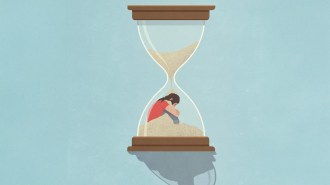A new treatment for debilitating nightmares offers sweeter dreams
A boost from a memory-enhancing technique improves the standard therapy for nightmare disorder

In a small study, a new treatment for nightmare disorder left people with fewer nightmares over a longer period than the standard treatment.
demaerre/Getty/iStock
- More than 2 years ago
For people haunted by recurring nightmares, untroubled sleep would be a dream come true. Now in a small experiment, neuroscientists have demonstrated a technique that, for some, may chase the bad dreams away.
Enhancing the standard treatment for nightmare disorder with a memory-boosting technique cut down average weekly nightmares among a few dozen people from three to near zero, researchers report online October 27 in Current Biology.
“The fact that they could actually make a big difference in the frequency of those nightmares is huge,” says Gina Poe, a neuroscientist at UCLA who wasn’t involved in the study.
People with nightmare disorder fear the night not for the monsters under the bed, but the monsters in their dreams. Frequent, terrifying dreams disturb sleep and even affect well-being in waking life. The go-to nightmare disorder treatment is imagery rehearsal therapy, or IRT. In this treatment, patients reimagine nightmares with a positive spin, mentally rehearsing the new story line while awake. It reduces nightmares for most but fails for nearly a third of people.
To boost IRT’s power, neuroscientist Sophie Schwartz of the University of Geneva and her colleagues leveraged a learning technique called targeted memory reactivation, or TMR. In this technique, a person focuses on learning something while a sound plays, and that same cue plays again during sleep. Experiencing the cue during sleep, which is important for memory storage, may reactivate and strengthen the associated memory (SN: 10/3/19).
In the new study, the researchers gave 36 people with nightmare disorder training in IRT, randomly assigning half of them to rehearse their revised nightmares in silence. The other half rehearsed while a short piano chord, the TMR cue, played every 10 seconds for five minutes.
For two weeks, participants practiced IRT daily and kept a dream diary. While they slept, a headband outfitted with sensors recorded their brains’ electrical activity and tracked their sleep stages. The piano chord served as a dream soundtrack, with the headband sounding off every 10 seconds during rapid eye movement, the sleep stage associated with dreaming. The headband played the sound for all participants, but only half had come to associate the sound with their new scenario during the IRT training.
For those trained on the chord, TMR nearly vanquished the nightmares, bringing the weekly average down from three to 0.2, and even encouraged happier dreams. The group that received only IRT improved too, but still averaged one weekly nightmare.
The TMR-IRT combination also had more staying power after three months, with that group’s average rising only slightly from about 0.2 to 0.3 nightmares a week, while the IRT-only group’s jumped to 1.5.
Larger studies will need to test how generalizable this treatment combination is. This study featured a small number of people, all young adults ages 20 to 35 who had nightmare disorder and no other psychiatric conditions. The study also didn’t compare IRT and TMR to no treatment, although the researchers write that previous studies have already shown how effective IRT can be.
If a TMR-IRT combo proves as strong in future research, it still has a way to go before it’s widely accessible. Commercially available sleep trackers in watches and rings have yet to distinguish between sleep stages as accurately as brain-monitoring tools.
Even with these caveats, the results are encouraging, Poe says. She suggests that future studies could test whether the TMR-IRT combination can help people with post-traumatic stress disorder, or PTSD, where nightmares rehash traumatic events (SN 9/12/14).
That’s something Schwartz wants to try. “I’m not sure we’ll succeed with these particular patients,” she says. “But if we do, this would be a really important addition to the methods we have for treating PTSD.”







